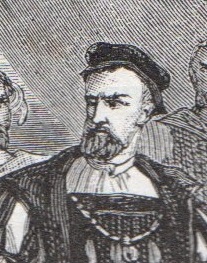Juan de Cartagena facts for kids
Quick facts for kids
Juan de Cartagena
|
|
|---|---|
 |
|
| Born | |
| Died | c. 1520 |
| Nationality | Castilian |
| Known for | Captaincy of a vessel in Magellan's Armada de Molucca, and ringleader of a mutiny in 1520 |
Juan de Cartagena (died around 1520) was a Spanish captain and a very important person on Ferdinand Magellan's famous trip around the world. He was in charge of one of the five ships. During the journey, Cartagena often disagreed with Magellan and questioned his decisions. After a failed attempt to take control of the ships (a mutiny), Magellan left Cartagena on a faraway island in Patagonia in 1520. Magellan then continued his journey towards the Strait of Magellan.
Contents
Early Life of Juan de Cartagena
Juan de Cartagena came from Burgos, an old city in Old Castile, Spain. He was a close friend and "nephew" of Juan Rodríguez de Fonseca. Fonseca was a very powerful leader of the Casa de Contratación. This was a special office that managed all trade with Spain's new lands in America. Historians believe that "nephew" might have meant he was Fonseca's son, but this is not certain. We don't know how old Cartagena was when he joined Magellan's trip. We do know he was married and had a daughter named Doña Catalina.
Joining Magellan's Big Voyage
Even though Cartagena was trained as an accountant (someone who manages money), he had no experience sailing ships. But he used his connections with Fonseca to get an important job. He became the Inspector General (Veedor General) for Magellan's fleet, called the Armada de Molucca. This meant he was in charge of checking all the money and trading for the trip.
King Charles V of Spain also told Cartagena to report directly to him, not through Magellan. This created a problem because both Magellan and Cartagena had a lot of power. To make Cartagena's supporters happy, Magellan made him captain of the biggest ship, the San Antonio. Cartagena earned a very high salary, even more than Magellan himself. He earned 110,000 maravedí, which was a lot of money back then.
Problems started between Cartagena and Magellan as soon as the ships left Spain. During meetings, Cartagena often disagreed with Magellan's sailing plans. He also refused to show respect to Magellan as his leader. When a storm hit and food became scarce, Cartagena openly criticized Magellan. He even suggested Magellan was not good enough to lead the fleet. Because of this, Magellan arrested Cartagena. He was removed from his command and kept on the ship Victoria for the rest of the trip to South America.
The Mutiny Against Magellan
Cartagena remained a prisoner until the fleet reached Patagonia. On April 1, 1520, he secretly left the Victoria. He went back to the San Antonio and gathered his supporters among the Spanish crew. They were against Magellan, who was Portuguese. Cartagena, along with the captain of the Concepción, Gaspar de Quesada, and the pilot Juan Sebastián Elcano, took control of the San Antonio. They said the ship was no longer under Magellan's command.
The officers of both the Concepción and Victoria joined the mutiny. On April 2, 1520, a letter was sent to Magellan's main ship, the Trinidad. The letter demanded that Magellan admit he was no longer in charge of the fleet.
Magellan moved the Trinidad next to the Victoria and sent a small boat with his reply. When the boat's crew got onto the Victoria's deck, they pretended to hand over a letter. When the Victorias captain reached for it, the boat crew attacked and killed him. At the same time, fifteen men from Magellan's ship climbed aboard and fought the mutineers. The Victorias crew then joined Magellan's side, and the ship was taken back.
Cartagena had moved to the Concepción before this fight, so he was still free for a short time. But now, only the Concepción and San Antonio were controlled by the mutineers. Magellan lined up his three ships across the entrance of the bay where they were anchored. He got ready to fight Cartagena's two ships. During a strong wind on the night of April 2, the San Antonio's anchor slipped. The ship drifted helplessly towards the Trinidad. Magellan ordered his ship to fire its cannons. The crew of the San Antonio quickly gave up, and the ship was taken back. Realizing the mutiny had failed, Cartagena also surrendered the Concepción without a fight on April 3.
What Happened to Juan de Cartagena?
After the mutiny, Magellan held a trial for those who had rebelled. Cartagena's friend, Gaspar de Quesada (the captain of the Concepción), was sentenced to death. However, Magellan did not want to execute Cartagena because he was a close relative of the powerful Fonseca. So, Cartagena was sentenced to be marooned. This meant he would be left alone on a deserted island. Another person involved, a priest named Pedro Sánchez de la Reina, was also marooned.
This punishment happened on August 11, 1520, about four months after the mutiny. It was just before the fleet left their winter camp at San Julián. Cartagena and the priest were given a small amount of ship's biscuits (a type of hard bread) and drinking water. They were left on a small island off the coast of Patagonia. No one ever saw or heard from them again.
Images for kids
See also
 In Spanish: Juan de Cartagena para niños
In Spanish: Juan de Cartagena para niños


